
The Greenfield Meeting House is a historic meeting house on Forest Road in the center of Greenfield, New Hampshire. The two-story wood-frame building was built in 1795; it is one of a small number of 18th century meeting houses in New Hampshire, and is believed to be the oldest still used for both religious and secular purposes, hosting both church services and town functions. The building was listed on the National Register of Historic Places in 1983.
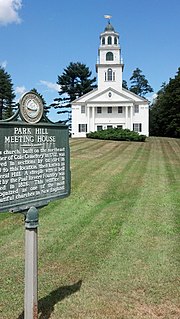
The Park Hill Meetinghouse is a historic meeting house on Park Hill in Westmoreland, New Hampshire. Built in 1764, and extensively restyled in the early 19th century, it is a fine example of Federal and Greek Revival architecture, influenced by the work of regionally prominent architect Elias Carter. The building was listed on the National Register of Historic Places in 1980. It is now owned by the Westmoreland Park Hill Meetinghouse and Historical Society.

The Smith Meeting House is a historic church at the junction of Meeting House and Governor Roads in Gilmanton, New Hampshire. Built about 1840, it is a well-preserved example of a vernacular 19th-century church building. The building was listed on the National Register of Historic Places in 1998.

The Early Settlers Meeting House is a historic church building at the junction of Granite and Foggs Ridge roads at Leighton Corners in the town of Ossipee, New Hampshire, United States. Built in the 1810s for a Free Will Baptist congregation and remodeled in 1856, it is a well-preserved example of a vernacular mid-19th century church. Now owned by the Ossipee Historical Society, the building was listed on the National Register of Historic Places in 1995.

The First Free Will Baptist Church is a historic church on Granite Road in Ossipee, New Hampshire. The wood-frame white clapboarded building was built in 1856–57, and is a fine little-altered local example of a vernacular Greek Revival country church. The building was listed on the National Register of Historic Places in 1984.

The Wolfeboro Centre Community Church is a historic church on New Hampshire Route 109 in Wolfeboro Center, New Hampshire. Built in 1841 for two separate congregations, it is a well-preserved example of a rural mid-19th century church. The building was listed on the National Register of Historic Places in 1984.

The First Congregational Church of Boscawen is a historic church at 12 High Street in Boscawen, New Hampshire. Built in 1799, the wood-frame church was significantly altered in 1839, when it acquired its present Greek Revival character. It is one of the few surviving meeting houses in New Hampshire that continues to combine religious and municipal functions; it basement space is used for town meetings and elections. The building was listed on the National Register of Historic Places in 1982.
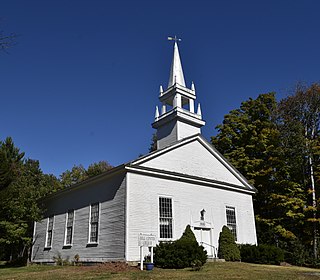
The Hill Center Church is a historic church on Murray Hill Road in Hill, New Hampshire. Built in 1799 and extensively altered in 1847, it is a well-preserved example of Gothic Revival architecture, used historically for both religious and civic functions in the town. Now maintained by a local community group, the building was listed on the National Register of Historic Places in 1985.

South Danbury Christian Church is a historic church at 675 US 4 in Danbury, New Hampshire. Built in 1867, it is a little-altered and well-preserved example of a rural vernacular church. The building was listed on the National Register of Historic Places in 1985.

Chester Congregational Church is a historic church at 4 Chester Street in Chester, New Hampshire. This wood-frame building was originally built as a traditional New England colonial meeting house in 1773, and underwent significant alteration in 1840, giving it its present Greek Revival appearance. It was listed on the National Register of Historic Places in 1986.
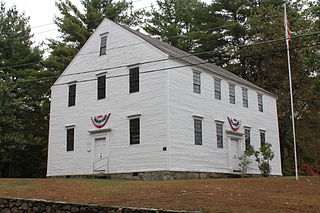
The Danville Meetinghouse is a historic colonial meeting house on North Main Street in Danville, New Hampshire. Construction on the building began in 1755 and was finished in 1760 when Danville petitioned to form a town of its own, separate from Kingston. It is the oldest meetinghouse of original construction and least-altered in New Hampshire, with a remarkably well preserved interior. The building, now maintained by a local nonprofit organization, was added to the National Register of Historic Places in 1982.

The Sandown Old Meetinghouse is a historic meeting house on Fremont Road in Sandown, New Hampshire. Built in 1773, this two-story timber-frame structure is a virtually unaltered late-Colonial civic and religious structure. It is believed to be unique in the state for its level of preservation, both internal and external. The building, now maintained by a nonprofit organization, was listed on the National Register of Historic Places in 1978, and the New Hampshire State Register of Historic Places in 2011.

The New Durham Meetinghouse and Pound are a historic colonial meeting house and town pound on Old Bay Road in New Durham, New Hampshire. Built in 1770, the wood-frame meeting house stands at what was, until about 1850, the center of New Durham, and was originally used for both civic and religious purposes. Now a public park, the property was listed on the National Register of Historic Places in 1980.

The Allenstown Meeting House is a historic meeting house on Deerfield Road in Allenstown, New Hampshire. Built in 1815, it is New Hampshire's only surviving Federal-style single-story meeting house to serve both religious and civic functions. It was listed on the National Register of Historic Places in December 2004, and the New Hampshire State Register of Historic Places in July 2004. It is presently owned and maintained by the town.

The Matthew Harvey House is a historic house on Harvey Street in Sutton, New Hampshire, and the centerpiece of Muster Field Farm, a working farm museum. Built in 1784, it is a prominent local example of Federal period architecture, and the homestead of a politically powerful family. The house was listed on the National Register of Historic Places in 1992.

The Old Webster Meeting House is an historic meeting house at 1220 Battle Street in Webster, New Hampshire. Built in 1791, and altered in the 1840s, the meeting house is one of a small number of 18th-century meeting houses to survive in northern New England. The building was moved from its original site in 1942 to make way for a flood control project and was given modern footings for the granite foundation in 1979. The building, owned by the Society for the Preservation of the Old Meeting House, now serves as a local museum. It was listed on the National Register of Historic Places in 1985.
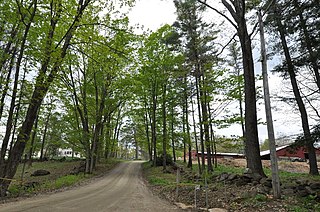
The John Adams Homestead/Wellscroft is a historic farmstead off West Sunset Hill Road in Harrisville, New Hampshire. The oldest portion of the farm's main house is a 1+1⁄2-story wood-frame structure built in the 1770s. It is one of the least-altered examples of early Cape style architecture in Harrisville, lacking typical alterations such as the additions of dormers and changes to the window sizes, locations, and shapes. The farmstead, including outbuildings and an area of roughly 2 acres (0.81 ha) distinct from the larger farm property, was listed on the National Register of Historic Places.

The Union Meetinghouse or Universalist Church is a historic church building at 97 Amesbury Road in Kensington, New Hampshire. Built in 1839-40, it is a well-preserved and little-altered example of a mid-19th century Greek Revival rural church. It was listed on the National Register of Historic Places in 2013, and continues to be used for summer services.

The Milton Town House is a historic civic and religious building at the junction of Town House Road and New Hampshire Route 125 in Milton, New Hampshire. Built in 1803 as a meeting place for civic and religious uses, it has served as Milton's town meeting site since then. It ceased religious functions in 1855, when it was reduced to a single story. The building was listed on the National Register of Historic Places in 1980.
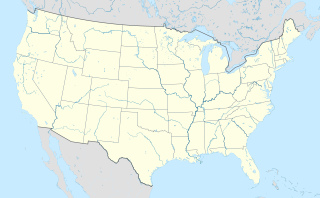
The Langdon Meeting House is a historic meeting house and former church at 5 Walker Hill Road in Langdon, New Hampshire. Completed in 1803 as a combination town hall and church, it is now a multifunction space owned by the town, and is claimed by the town to hold the record for consecutive town meetings held in the same space. The building was listed on the National Register of Historic Places in 2020, and the New Hampshire State Register of Historic Places in 2012.























